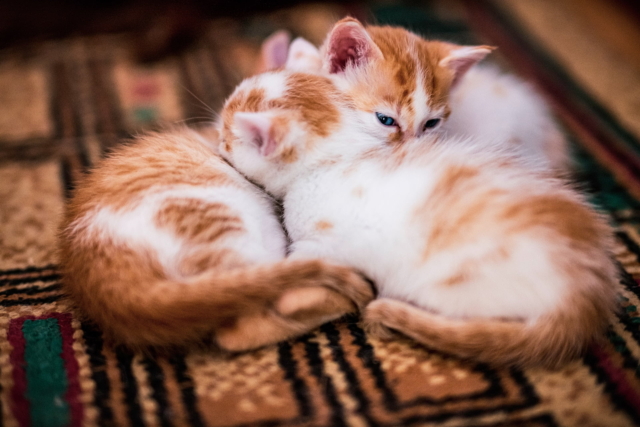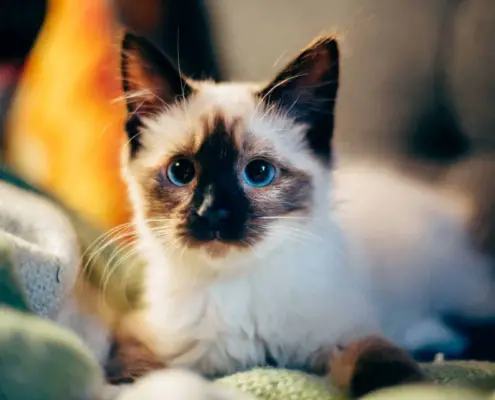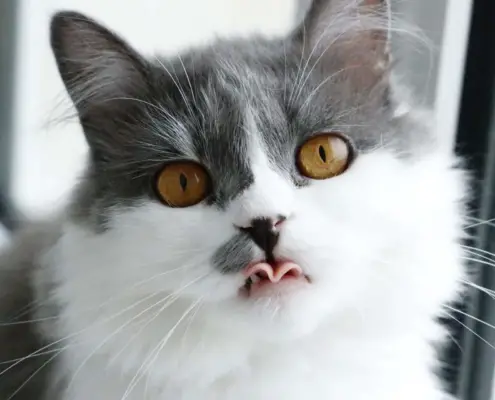
Cats are known for their love of sleep. They can often be found curled up in a cozy spot, snoozing away the day. But have you ever wondered just how long cats can go without sleeping? Understanding the sleeping habits of cats is essential for ensuring their overall well-being.
Cats are crepuscular animals, which means they are most active during dawn and dusk. However, they still need a significant amount of sleep to remain healthy. On average, cats sleep for about 12 to 16 hours a day, with some cats sleeping up to 20 hours. This extended sleep duration is due to their evolutionary history as predators, where they needed to conserve energy between hunting sessions.
The Importance of Sleep for Cats
Sleep is crucial for cats as it plays a vital role in their physical and mental health. During sleep, cats go through different sleep stages, including deep sleep and REM (rapid eye movement) sleep. These stages are essential for their overall well-being.
Deep sleep allows cats to rest and recharge their bodies. It is during this stage that their muscles relax, and their bodies repair themselves. REM sleep, on the other hand, is when cats dream. It helps with memory consolidation and enhances their cognitive abilities.
A lack of sleep can have detrimental effects on a cat’s health. Sleep deprivation can lead to irritability, decreased immune function, and even obesity. It is essential to provide cats with a conducive sleep environment and ensure they get enough rest.
How Long Can Cats Go Without Sleeping?
Cats are highly dependent on regular sleep. While the exact duration they can go without sleeping varies from cat to cat, most felines cannot go more than a couple of days without sleep. Extended periods of wakefulness can lead to exhaustion and other health problems.
If you notice your cat consistently staying awake for prolonged periods or struggling to fall asleep, it is essential to consult with a veterinarian. They can help identify any underlying medical conditions or behavioral issues that may be affecting your cat’s sleep patterns.
Factors That Affect a Cat’s Sleep Patterns
Several factors can influence a cat’s sleep patterns. These include age, health, environment, and daily routine. Kittens and older cats tend to sleep more than adult cats. Cats with underlying health issues may also experience changes in their sleep patterns.
The environment plays a crucial role in a cat’s sleep habits. Cats prefer quiet and comfortable spaces where they can feel safe and secure. Temperature, lighting, and the presence of other pets or humans can also impact their ability to fall asleep and stay asleep.
Establishing a consistent daily routine can help regulate a cat’s sleep patterns. Cats thrive on predictability, so sticking to a regular feeding and play schedule can promote better sleep.
Signs of Sleep Deprivation in Cats
It is important to be aware of the signs of sleep deprivation in cats. If your cat is not getting enough sleep, they may display the following symptoms:
- Excessive daytime sleepiness: If your cat seems drowsy or lethargic during the day, it may be a sign of sleep deprivation.
- Irritability or aggression: Lack of sleep can make cats irritable and more prone to aggressive behavior.
- Decreased grooming: Cats are known for their grooming habits. If your cat’s grooming routine has declined, it could be a result of sleep deprivation.
- Decreased appetite: Sleep deprivation can affect a cat’s appetite, leading to a decreased interest in food.
- Restlessness: Cats deprived of sleep may exhibit restlessness, pacing, or difficulty settling down.
If you notice any of these signs, it is crucial to address your cat’s sleep needs and consult with a veterinarian if necessary.
Tips for Ensuring Your Cat Gets Enough Sleep
To ensure your cat gets enough sleep, consider the following tips:
- Provide a cozy sleep environment: Create a quiet and comfortable space for your cat to sleep. Provide a soft bed or blanket and ensure the area is free from any disturbances.
- Establish a routine: Stick to a consistent daily routine for feeding, playtime, and sleep. Cats thrive on predictability, and a structured routine can help regulate their sleep patterns.
- Provide mental and physical stimulation: Engage your cat in interactive play sessions to tire them out mentally and physically. This can help promote better sleep.
- Avoid disruptions: Minimize any disruptions that could disturb your cat’s sleep, such as loud noises or sudden changes in the environment.
- Consult a veterinarian: If you are concerned about your cat’s sleep patterns, consult with a veterinarian. They can provide guidance and address any underlying health issues that may be affecting your cat’s sleep.
Common Misconceptions About Cat Sleep
There are several common misconceptions about cat sleep that need to be addressed. One of the most prevalent misconceptions is that cats are nocturnal animals. While they are more active during dawn and dusk, cats are not strictly nocturnal. They are crepuscular, meaning they are most active during low-light periods.
Another misconception is that cats sleep all day because they are lazy. In reality, cats sleep for extended periods because they need to conserve energy. Their sleeping habits are deeply rooted in their evolutionary history as predators.
Understanding these misconceptions can help foster a better understanding of cat sleep and ensure that cats receive the care and attention they need.
Understanding the Different Sleep Stages in Cats
Cats go through different sleep stages, each serving a specific purpose. These stages include:
- Non-REM sleep: This is the stage where cats enter deep sleep. Their muscles relax, and their bodies repair themselves. Non-REM sleep helps cats recover and recharge.
- REM sleep: REM sleep is when cats dream. During this stage, their brains are highly active, and their eyes may move rapidly under their closed eyelids. REM sleep plays a crucial role in memory consolidation and cognitive function.
Understanding these sleep stages can help cat owners recognize the signs of healthy sleep and ensure their cats are getting the rest they need.
How to Create a Conducive Sleep Environment for Your Cat
Creating a conducive sleep environment for your cat is essential for promoting healthy sleep. Consider the following tips:
- Provide a comfortable bed or sleeping area: Cats prefer soft and cozy surfaces for sleep. Provide a comfortable bed or blanket in a quiet area where your cat can relax.
- Control the lighting: Cats are sensitive to light. Ensure the sleep environment has minimal light to mimic natural nighttime conditions.
- Maintain a comfortable temperature: Cats are sensitive to temperature changes. Keep the sleep area at a comfortable temperature to ensure your cat can sleep peacefully.
- Minimize noise: Cats are easily startled by loud noises. Keep the sleep area quiet and free from any disturbances.
- Consider pheromone products: Pheromone products, such as diffusers or sprays, can help create a calming environment for your cat and promote better sleep.
By creating a conducive sleep environment, you can help your cat get the rest they need for optimal health and well-being.
Conclusion
Cats are creatures of habit, and their sleep habits are no exception. Understanding the sleeping patterns of cats is crucial for ensuring their overall well-being. On average, cats sleep for about 12 to 16 hours a day, with some sleeping up to 20 hours. However, cats cannot go more than a couple of days without sleep, as it can lead to exhaustion and other health problems.
Factors such as age, health, environment, and routine can influence a cat’s sleep patterns. Creating a conducive sleep environment and providing mental and physical stimulation can help ensure your cat gets enough sleep. If you notice signs of sleep deprivation in your cat, it is important to consult with a veterinarian to address any underlying issues.
By prioritizing your cat’s sleep needs, you can contribute to their overall health and happiness. So, create a cozy sleep environment, establish a routine, and provide the care and attention your feline friend deserves.
If you enjoyed my article, I would appreciate you sharing it with your network.

Sima Ndlebe
Sima writes for CatBuzz. He is interested in Cats, Health and Fitness, and Entrepreneurship.
Published: 17 November 2023
Related Articles
Disclaimer
The content found on CatBuzz.org is presented on an "as is" basis and is intended for general consumer information and education purposes only. Any utilization of this information is voluntary and solely at the user's own risk.
None of the articles or content should be regarded as, or used in place of, veterinary medical advice, diagnosis, or treatment. The information provided on the website is purely for educational and informational intentions and should not be considered a substitute for professional guidance from a veterinarian or other qualified expert. The articles are designed to inform consumers about veterinary healthcare and medical matters that may impact their cat's daily life. It should be noted that this website and its services do not constitute the practice of any form of veterinary medical advice, diagnosis, or treatment. CatBuzz.org explicitly disclaims any liability for any direct or indirect damages or losses that may arise from the use of or reliance on the information contained within the content.
Consumers must consult a veterinarian, veterinary specialist, or another qualified veterinary healthcare provider when seeking advice regarding their cat's health or medical conditions. It is important not to ignore, avoid, or postpone seeking medical advice from a veterinarian or other qualified veterinary healthcare provider solely based on information obtained from this website. If you believe that your cat may be experiencing a medical issue or condition, it is imperative to promptly contact a qualified veterinary healthcare professional.



